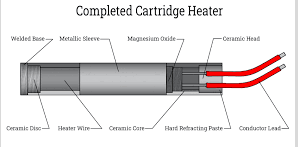Depending on the cartridge heater that you select, you might experience varying degrees of influence in regards to your application’s performance, efficiency, and durability. Most industries require cartridge heaters for high precision heating requirements, and before selecting one, several factors must be considered. Cartridge Heaters Market size was valued at USD 541.1 Million in 2023 and is expected to reach USD 749.8 Million by 2030 with a CAGR of 4.9% from 2024-2030.
Here are the greatest ten recommendations to assist you in selecting the ideal cartridge heater for your requirements:
Here are the greatest ten recommendations to assist you in selecting the ideal cartridge heater for your requirements:
Table of Contents
- Know Your Application’s Requirements
- Correct Watt Density
- Choose the Correct Size and Fit
- Consider what the Sheath was made of
- Evaluate the Voltage and Power Needs
- Look for a Uniform Heat Distribution
- Review the Lead Wire Configuration
- Temperature control selections
- Manufacturer Quality and Specifications
- Think About Customization Choices
- Conclusion
To find the best cartridge heater, you need to get an understanding of the application specifics that you require. Consider such factors as the environment temperature, the content of the substance to be heated, the time taken to heat up, and the temperature at which the substance is expected to operate. It pays to make these specifications very clear because they will help you decide on the most appropriate heater.
Watt density is defined as watts per square inch and it is as crucial an aspect as the heating performance. While there are possibilities of complicated heat control leading to overheating within the system, higher watt densities have shorter heat-up times. Effectiveness can therefore be assured by equating the watt density to the thermal conductivity and heat dissipation characteristic of the application in question.

The cartridge heater’s diameter and length are changeable. In other words, successful heat conduction or heat protection depends on the correct contact of the heating element and its surrounding housing or bore. If child’s play to install and remove, then try and measure the bore accurately and choose a heater which is slightly smaller in diameter.
The type of material exposed to heat as well as the environment must also be compatible to the material used in producing the sheath of the cartridge heater. Some of the common metals used in the production of sheaths are brass, Incoloy, and stainless steel. Being a non-oxidizing and non-corrosive metal, stainless steel has its application in almost all sectors of the economy. Brass is ideal for low-temperature services however Incoloy offers unparalleled high-temperature resilience.
Check that the power and voltage ratings of the cartridge heater correspond with the electrical requirements of your application. Incorrect voltage use of a heater might result in poor performance or even heater damage. It’s also critical to think about how much the power supply can provide for the heater.

Achieving constant heating and preventing hotspots need even heat dispersion. Select a cartridge heater with an equally distributed wattage pattern or inbuilt thermal expansion coils that encourage uniform heat distribution.
You Should Also Need to read this Blog : The Top 15 Advantages of Bobbin Heater Elements
Your installation as well as operating requirements should be met by the arrangement of the lead wire. The leads that can be saturated in the common configurations are the flexible leads, right angle lead, and straight leads. Also consider what the insulation of the lead wire is constructed from, especially in the case of a heater for corrosive or high-temperature environments.
Maintaining the correct temperature and most importantly, not burning your coffee requires a careful approach to temperature regulation. When you need high accuracy in temperature settings and control, some options to consider are cartridge heaters with thermocouples or integrated temperature control. Another strategy is to use separate external temperature sensors that are compatible with heaters.

It is an important fact that cartridge heaters are not created in the same way. Click on the tolerances, life expectancy, and warranty of the product according to the specifications of the manufacturer. Purchase heater models with components from well-developed and high-caliber manufacturers. Other relevant data such as the efficiency of the heater and its durability might also be obtained from those user reviews and feedbacks.
Search for unique cartridge warmers if they are necessary for your application. Some of the options that a customer can choose from include lead wire layout, watt density, length, and diameter from the few suppliers available. Custom heaters are designed to ensure that they perfectly fit into the required application to offer the best performance.
Carefully weighing application needs, watt density, size, sheath material, voltage, and temperature control choices is necessary to choose the best cartridge heater for your application. By using these top ten recommendations, you can be sure you choose a cartridge heater that will satisfy your requirements, heat uniformly and efficiently, and function dependably during its life.
Spending some time choosing the right heater will pay you in longer heater life, lower downtime, and increased efficiency—all of which will enhance the overall performance of your application.
Spending some time choosing the right heater will pay you in longer heater life, lower downtime, and increased efficiency—all of which will enhance the overall performance of your application.
